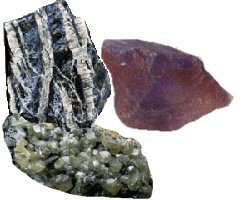
August Editorial

August Editorial
Our mineralogically diverse planet |
|
There is still much to learn about the Earth's minerals. Nearly a decade ago Robert Hazel of the Carnegie Institute postulated that our planet contains approximately 5,000 mineral types. Many of those minerals might well exist on any Earth-like planet, but some are definitely unique to Earth. Hazel and his co-workers proposed that this unique mineral make-up is due primarily to the existence of life. For example, bacterial photosynthesis some 2.4 billion years ago was directly linked to the dramatic increase in atmospheric oxygen levels, which in turn affected the minerals which formed at this time. Consequently Hazen et al. believe that as much as two-thirds of all the minerals found on Earth are specific to this planet. |
|
|
The team's latest research also suggests that there may be more than 1500 minerals which still await discovery. New mineral types are determined by their their unique chemical and crystal structure. However, as Hazen points out, some of those new types may be difficult to characterise because of their chemical and physical characteristics. For example white minerals are more difficult to spot than minerals which have a specific colour. Water solubility, stability in the Earth’s crust are also important factor as as are secondary reactions with oxygen and other interactions with life forms on planet Earth. Taking all these factors into account, Hazen and his colleagues predict that nearly 35%t of all sodium minerals remain undiscovered because more than half of them are white, poorly crystallized, water soluble or all of the above. By contrast, more than 80% of copper, magnesium, and copper minerals have probably been discovered. There is also a definite possibility that some minerals may never be discovered. Some minerals may have once existed on the Earth's surface but have since been lost forever by burial, erosion, or subduction back into the mantle, while the changing conditions on the Earth’s surface means these minerals will never be recreated. Hazen's team were also interested in the distribution of minerals on our planet. They used both statistical models of ecosystem research and extensive analysis of mineralogical databases to explore this question. They found, not surprisingly, that the more abundant minerals are found in multiple places. However, the probability that a particular mineral is found only in one locality is about 22%, whereas the probability that it is found at ten or fewer locations is about 65%. In fact the team go further and say that most mineral types are found in fewer than five locations. So in fact most of the Earth’s minerals should be considered rare. As Hazen explains: 'Minerals follow the same kind of frequency of distribution as words in a book. For example, the most-used words in a book are extremely common such as 'and,' 'the,' and 'a.' Rare words define the diversity of a book's vocabulary. The same is true for minerals on Earth. Rare minerals define our planet's mineralogical diversity.' Giving that minerals can be directly linked to the presence of living organisms, and the fact that these organisms have a unique genetic make-up, Earth’s mineral ‘ecosystem’ is likely to evolve further in future. Furthermore, if we could turn the clock and start again, our planet would end up with a different mineralogical diversity. This suggests that the Earth's mineralogy is unique in the cosmos and could not be replicated anywhere else. Journal Reference: | |
| _______________________________ | ||||
| Home | | | Shopping | | | Database |
© Biscuit Software 2004-2015
All rights reserved